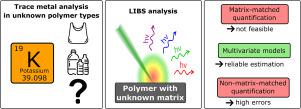Spectrochimica Acta Part B: Atomic Spectroscopy ( IF 3.2 ) Pub Date : 2021-08-08 , DOI: 10.1016/j.sab.2021.106272 Lukas Brunnbauer , Jhanis Gonzalez , Hans Lohninger , Julia Bode , Carla Vogt , Michael Nelhiebel , Silvia Larisegger , Andreas Limbeck

|
Providing unique advantages, laser-based analytical techniques such as LIBS have gained more and more popularity for quantitative elemental analysis in the last few years. However, to obtain reliable quantitative results, matrix-matched standards are required. A particular material of interest for quantitative trace metal analysis is synthetic polymers, which is among the most widely used materials in our modern world. As the exact composition of a polymer under investigation (polymer type and applied additives) is often not known, the selection of an appropriate matrix-matched standard is difficult. In this work, we investigate and assess different approaches for quantifying potassium in unknown polymer types or polymers with an unknown composition where matrix-matched standards cannot be employed. This is of great interest in the semiconductor industry where monitoring of mobile ions in applied polymers is crucial, and the composition of the polymer is often not known due to confidentiality. We use the unique capabilities of LIBS, providing adequate sensitivity for potassium, and additionally delivering polymer-specific emission signals. Two different multivariate approaches (Random Decision Forest classification combined with conventional univariate calibration and a Partial Least Squares model) are developed and applied. Therefore, an in-house prepared library of standards of 8 different polymer types (Acrylic, PAN, PI, PMMA, PSU, PVA, PVC and PVP) is prepared. The errors obtained from the multivariate approaches are compared with conventional matrix-matched as well as non-matrix-matched quantification. With our developed approaches, for some samples quantitative determination of potassium in the low μg/g range in unknown polymer types is achieved with a relative error less than 20% which is comparable to conventional matrix-matched quantification. For all other samples, relative errors in the range of 30%–90% are obtained, which offers a precision adequate for many applications. E.g. in the food-packaging- or semiconductor-industry in many cases it is sufficient to determine if the contamination level of a sample with an unknown matrix is below or above a certain threshold. In this case, the developed approach poses a significant improvement compared to non-matrix-matched quantification which often leads to deviations up to a factor 10 or more from the nominal concentration.
中文翻译:

使用 LIBS 对基质未知的聚合物样品中痕量金属进行定量的策略
在过去几年中,基于激光的分析技术(如 LIBS)具有独特的优势,在定量元素分析中越来越受欢迎。然而,为了获得可靠的定量结果,需要基质匹配的标准品。用于定量痕量金属分析的一种特殊材料是合成聚合物,它是现代世界中使用最广泛的材料之一。由于正在研究的聚合物的确切组成(聚合物类型和应用的添加剂)通常是未知的,因此很难选择合适的基质匹配标准。在这项工作中,我们研究和评估了量化未知聚合物类型或具有未知成分的聚合物中钾的不同方法,其中不能使用基质匹配的标准。这在半导体行业引起了极大的兴趣,在该行业中,监测应用聚合物中的移动离子至关重要,并且由于机密性,聚合物的成分通常是未知的。我们利用 LIBS 的独特功能,为钾提供足够的灵敏度,并额外提供聚合物特定的发射信号。开发并应用了两种不同的多变量方法(随机决策森林分类与传统的单变量校准和偏最小二乘模型相结合)。所以 开发并应用了两种不同的多变量方法(随机决策森林分类与传统的单变量校准和偏最小二乘模型相结合)。所以 开发并应用了两种不同的多变量方法(随机决策森林分类与传统的单变量校准和偏最小二乘模型相结合)。所以,内部准备了 8 种不同聚合物类型(丙烯酸、PAN、PI、PMMA、PSU、PVA、PVC 和 PVP)的标准库。将从多元方法获得的误差与传统的矩阵匹配和非矩阵匹配量化进行比较。使用我们开发的方法,对于未知聚合物类型中低 μg/g 范围内的钾的某些样品的定量测定实现了小于 20% 的相对误差,这与传统的基质匹配定量相当。对于所有其他样品,获得了 30%–90% 范围内的相对误差,这为许多应用提供了足够的精度。例如,在食品包装或半导体行业中,在许多情况下,确定具有未知基质的样品的污染水平是否低于或高于某个阈值就足够了。











































 京公网安备 11010802027423号
京公网安备 11010802027423号